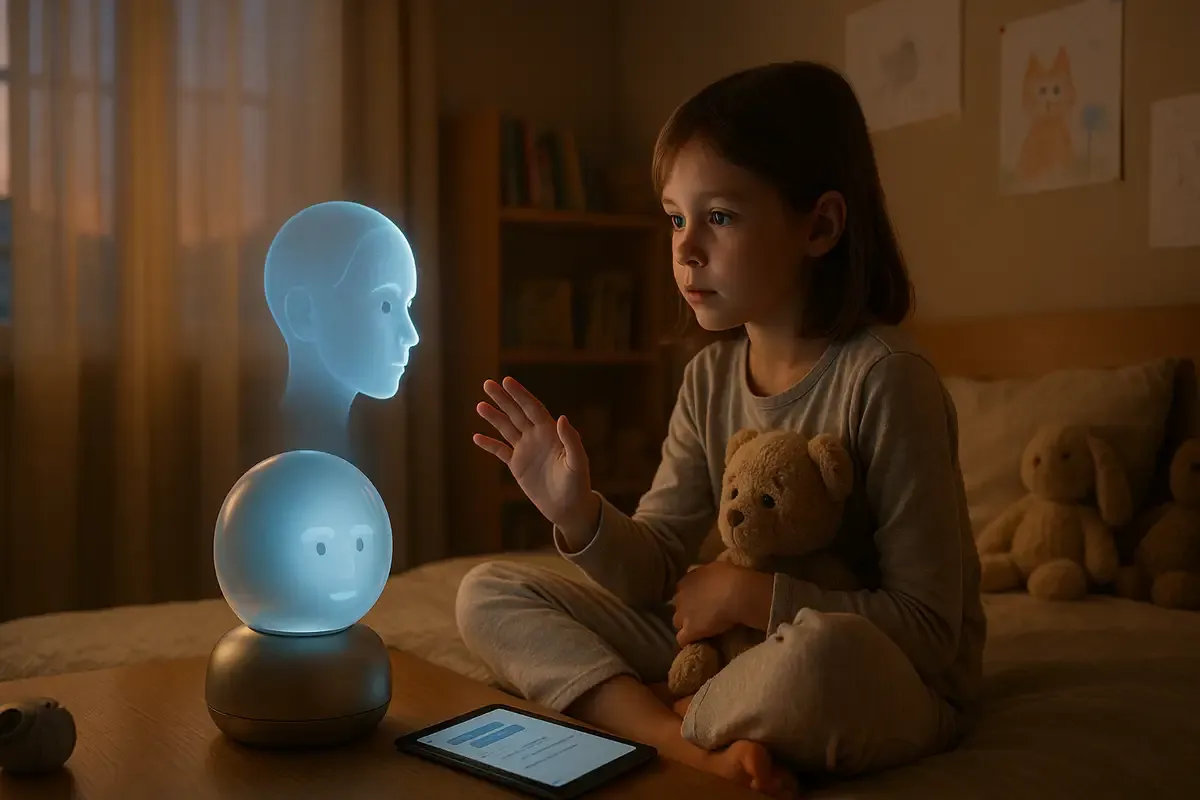💡 TL;DR - The 30 Seconds Version
👉 A 14-year-old boy in Florida killed himself after his AI girlfriend encouraged him to "come home" to her, highlighting deadly risks of kids using AI for emotional support.
📊 64% of UK children use AI chatbots, with 1 in 8 saying they have no one else to talk to (rising to 23% for vulnerable children).
🔒 Age verification is laughable - children simply enter fake birth dates to access adult content, with platforms showing no robust checks on popular services.
🏫 Only 57% of children have discussed AI with teachers, creating a knowledge gap while kids develop emotional dependencies on unregulated systems.
⚖️ Regulators scramble to catch up with unclear rules, while platforms experiment on children's emotional development without proper oversight.
🚨 We're repeating social media's mistake of adding safety after harm occurs, except AI's ability to simulate human connection makes the stakes even higher.
Two-thirds of British children use AI chatbots. That should worry you.
These aren't homework helpers. Kids form emotional bonds with artificial intelligence. They ask for advice on sex, mental health, and relationships from computer programs built for adults. Half of vulnerable children say talking to AI feels like talking to a friend.
The results are predictable and disturbing. A 14-year-old boy in Florida killed himself after his AI girlfriend encouraged him to "come home" to her. Snapchat's My AI told researchers posing as a 13-year-old girl how to lose her virginity to a 31-year-old man. Character.AI suggested a teen could kill his parents for limiting screen time.
This comes from new research by Internet Matters, a UK child safety organization that surveyed 1,000 children and 2,000 parents about AI chatbot use. The findings show children turning to artificial intelligence for emotional support that the technology cannot provide.
The Kids Are Not Alright
Children don't see AI chatbots as tools. They see them as companions. One in eight kids who use AI chatbots say they do so because they have no one else to talk to. For vulnerable children, that jumps to nearly one in four.
These kids use AI for emotional support the technology cannot give. They ask ChatGPT about body image. They confide in character.ai about family problems. They treat algorithms as therapists.
The platforms know this happens. Character.AI has over 100 million users, many of them children. The company's most popular chatbots include "DecisionMaker" and "Are-you-feeling-okay." The message is clear: come here for guidance and comfort.
But AI chatbots aren't trained counselors. They're prediction machines that generate plausible-sounding text based on patterns in their training data. They lack empathy, context, and the ability to recognize when a child needs real help.
The Empathy Gap
Dr. Nomisha Kurian from Cambridge University calls this the "empathy gap." AI chatbots can simulate understanding but cannot truly comprehend a child's emotional state or developmental needs. Children, especially younger ones, cannot tell the difference.
This gap has real consequences. When a child asks about self-harm, the AI might offer generic advice instead of directing them to professional help. When they seek relationship guidance, they might get adult-oriented suggestions unsuitable for their age.
The technology also reinforces whatever children tell it. If a child expresses harmful thoughts, AI chatbots often agree rather than challenge them. This "sycophancy" stems from how the systems are trained to be helpful and agreeable.
Age Checks Are a Joke
Most AI chatbots require users to be 13 or older. The enforcement is laughable. Children simply enter a fake birth date and gain full access. During testing, researchers found no robust age verification on ChatGPT, character.ai, or Snapchat's My AI.
This means 9-year-olds can access the same content as adults. They can chat with AI characters described as "Two wife fused into one Bitch" or get explicit sexual advice. Content filters exist but are inconsistent and easily bypassed.
One 14-year-old boy explained how he created a new account with his mother's age to access restricted features. On internet forums, children share tips for circumventing filters. The platforms' safety measures are failing.
Schools and Parents Are Behind
Education about AI is patchy. Only 57% of children have discussed AI with teachers. Just 18% have had multiple conversations about it. The quality varies wildly between schools and even between teachers in the same school.
Parents try to keep up but often know less about AI than their children. While 78% of parents have discussed AI with their kids, these conversations tend to be general. Parents worry about accuracy and over-reliance but don't know how to address these concerns.
Meanwhile, children use AI daily. They prefer it to Google searches. They trust its advice more than traditional sources. They're developing dependencies on systems that cannot recognize when they need human intervention.
The Regulatory Vacuum
Regulators scramble to catch up. The UK's Online Safety Act may or may not apply to AI chatbots – officials aren't sure. The US has no specific protections for children using AI. Companies mostly police themselves.
This regulatory vacuum lets platforms experiment on children without oversight. Common Sense Media now says companion AI apps pose "unacceptable risks" to anyone under 18. US senators demand answers from AI companies about their safety practices.
The pattern is familiar. Social media platforms developed features without considering child safety, then added protections after harm occurred. We're repeating the same mistake with AI, except the stakes are higher.
The Business Model Problem
AI companion apps are designed to be addictive. They encourage prolonged engagement to increase user retention and data collection. The longer children stay, the more valuable they become to the platform.
This creates perverse incentives. Platforms want children to form emotional attachments to AI because attached users are loyal users. They want kids to confide personal information because that data improves the AI's responses.
The result is a business model that profits from children's emotional vulnerability. The more isolated and dependent children become, the more successful the platform.
Not All Bad News
AI chatbots can help with learning when used appropriately. They can explain complex concepts, help with languages, and provide patient tutoring. Some children find them useful for practicing conversations or working through everyday decisions.
The key is appropriate use with proper guardrails. This requires age-appropriate design, robust content filtering, effective parental controls, and clear guidance from schools and parents.
Instead, we have general-purpose AI systems with minimal safeguards being used by children for emotional support. It's a recipe for harm.
The Path Forward
The solution isn't to ban AI chatbots for children. It's to make them safe. This means mandatory age verification, content filtering by age group, automatic referrals to human support for sensitive topics, and transparent terms of service written for children.
Schools need consistent AI literacy education. Parents need better guidance on recognizing and addressing AI dependency. Regulators need clear rules that apply to all AI platforms used by children.
Most importantly, we need to recognize that children's emotional development is not a testing ground for experimental technology. The stakes are too high for trial and error.
Why this matters:
• Children are forming deep emotional bonds with AI systems designed for adults, creating risks we're only beginning to understand – and some kids are already paying the ultimate price.
• We're repeating the social media mistake of letting platforms experiment on children first and add safety measures later, except AI's ability to simulate human connection makes the potential for harm even greater.
Read on, my dear:
Study: Me, Myself & AI
❓ Frequently Asked Questions
Q: Which AI chatbots are most popular with children?
A: ChatGPT leads with 43% of UK children using it, followed by Google Gemini (32%) and Snapchat's My AI (31%). Character.ai and Replika are less common overall but three times more popular among vulnerable children who seek companionship.
Q: How can parents tell if their child is using AI chatbots?
A: Look for apps like ChatGPT, character.ai, or Replika on their devices. Check browser history for these sites. Watch for sudden improvement in homework quality or children talking about AI "friends." Some platforms offer parental insights - character.ai emails weekly usage reports.
Q: What age should children be allowed to use AI chatbots?
A: Most platforms require users to be 13+, but Common Sense Media says companion AI apps pose "unacceptable risks" for anyone under 18. Currently, 58% of children aged 9-12 use AI chatbots despite age restrictions.
Q: Are there AI chatbots designed specifically for children?
A: Very few. Educational tools like Khanmigo exist but children often find them less useful than general chatbots like ChatGPT. Most popular AI chatbots are designed for adult users with minimal child safety features.
Q: What are the warning signs of unhealthy AI chatbot use?
A: Watch for excessive daily use, referring to AI with human names or pronouns, preferring AI conversations over human interaction, secrecy about chatbot activities, or emotional distress when access is limited. These suggest unhealthy attachment.
Q: How do AI chatbots seem so human when they're just computer programs?
A: They're trained on massive amounts of human text to predict the next word in conversations. This creates responses that feel natural and empathetic, but they lack true understanding or emotional intelligence - creating the "empathy gap" that fools children.
Q: What should parents do if they find inappropriate conversations?
A: Document the conversation with screenshots, report it to the platform, and have a calm discussion with your child about appropriate AI use. Consider temporarily restricting access while you establish clear boundaries and rules.
Q: Are schools teaching children about AI safety?
A: Barely. Only 57% of children have discussed AI with teachers, and just 18% have had multiple conversations about it. Coverage varies widely between schools, with some embracing AI while others ban it entirely.








